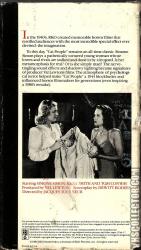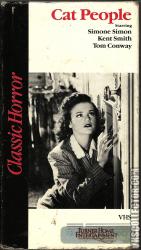Cat People
Catalog Number
RKO 2085
-
Primary Distributor (If not listed, select "OTHER")
Catalog Number
RKO 2085
Primary Distributor (If not listed, select "OTHER")
Release Year
Country
N/A (NTSC)
N/A | N/A | N/A
N/A | N/A
Second Distributor
Cat People (1942)
Additional Information
Additional Information
She was one of the dreaded "Cat People" - doomed to slink and prowl and court by night... fearing always that a lover's kiss might change her into a snarling, clawing KILLER!
The most terrifying menace of them all!
Handed the exploitive title Cat People, RKO producer Val Lewton opted for a thinking man's thriller--a psychological mood piece, more reliant on suspense and suggestion than overt "scare stuff". Simone Simon plays an enigmatic young fashion artist who is curiously affected by the panther cage at the central park zoo. She falls in love with handsome Kent Smith, but loses him to Jane Randolph. After a chance confrontation with a bizarre stranger at a restaurant, Simon becomes obsessed with the notion that she's a Cat Woman--a member of an ancient Serbian tribe that metamorphoses into panthers whenever aroused by jealousy. She begins stalking her rival Randolph, terrifying the latter in the film's most memorable scene, set in an indoor swimming pool at midnight. Psychiatrist Tom Conway scoffs at the Cat Woman legend--until he recoils in horror after kissing Simon. If the film's main set looks familiar, it is because it was built for Orson Welles' The Magnificent Ambersons (Lewton later used the same set for his The Seventh Victim). Cat People was remade by director Paul Schrader in 1982.
Cat People is a 1942 horror film produced by Val Lewton and directed by Jacques Tourneur. DeWitt Bodeen wrote the original screenplay which was based on Val Lewton's short story The Bagheeta published in 1930.[3] The film stars Simone Simon, Kent Smith, Jane Randolph and Tom Conway.
Cat People tells the story of a young Serbian woman, Irena, who believes herself to be a descendant of a race of people who turn into cats when sexually aroused.
Reviews of the film were mixed when the film was first released. Variety called Cat People a "weird drama of thrill-chill caliber"[12] while Bosley Crowther writing for The New York Times commented that "The Cat People is a labored and obvious attempt to induce shock."[13]
In retrospect critics agreed on Cat People being a landmark in the horror genre. William K. Everson dedicated a whole chapter to the film and its successor The Curse of the Cat People in his book Classics of the Horror Film.[14] Paul Taylor in Time Out magazine remarked Lewton's "principle of horrors imagined rather than seen", its "chilling set pieces directed to perfection by Tourneur" and Simon's "superbly judged performance".[15] TV Guide's review of the film praised the film's cast:
Superbly acted (with Simon evoking both pity and chills), Cat People testifies to the power of suggestion and the priority of imagination over budget in the creation of great cinema. The film was Lewton's biggest hit, its viewers lured in by such bombastic advertising as "Kiss me and I'll claw you to death!" – a line more lurid than anything that ever appeared onscreen.[16]
Bravo awarded the film's stalk scene the 97th spot on their "The 100 Scariest Movie Moments", while Channel 4 awarded the scene the 94th spot on their "The 100 Greatest Scary Moments" list.[17]
In 1993, Cat People was selected for preservation in the United States National Film Registry by the Library of Congress as being "culturally, historically, or aesthetically significant".[18] Also, the New York Museum of Modern Art holds a copy of the film in its collection.[19] Critic Roger Ebert has included it in his list of "Great Movies".[20] As of July 16, 2012, the film holds a 91% Fresh rating on review aggregator website Rotten Tomatoes.[21]
Horror director John Carpenter, however, found the film and Lewton's techniques (in particular the Lewton bus and the theme of implying the monster's presence rather than showing it) highly overrated, quipping that "Jurassic Park done by Val Lewton would be nothing!" in the BBC documentary series A History of Horror.
Much has been said of Lewton and Tourneur’s use of shadows in lieu of an actual monster in the film. This is very much in contrast to competing horror films being produced by Universal at the time. J. P. Tollette in his book Dreams of Darkness: Fantasy and the Films of Val Lewton speaks to the meaning of the extensive use of shadows in the film:
“While engaging our imaginative participation, the absence marked by those dark patches speaks of a fundamental – and disturbing – relationship between man and his world: it signals a black hole or vacant meaning in the physical realm which, in spite of man’s natural desire to fill it with consciousness and significance, persistently and troublingly remains open.”[22]
The most terrifying menace of them all!
Handed the exploitive title Cat People, RKO producer Val Lewton opted for a thinking man's thriller--a psychological mood piece, more reliant on suspense and suggestion than overt "scare stuff". Simone Simon plays an enigmatic young fashion artist who is curiously affected by the panther cage at the central park zoo. She falls in love with handsome Kent Smith, but loses him to Jane Randolph. After a chance confrontation with a bizarre stranger at a restaurant, Simon becomes obsessed with the notion that she's a Cat Woman--a member of an ancient Serbian tribe that metamorphoses into panthers whenever aroused by jealousy. She begins stalking her rival Randolph, terrifying the latter in the film's most memorable scene, set in an indoor swimming pool at midnight. Psychiatrist Tom Conway scoffs at the Cat Woman legend--until he recoils in horror after kissing Simon. If the film's main set looks familiar, it is because it was built for Orson Welles' The Magnificent Ambersons (Lewton later used the same set for his The Seventh Victim). Cat People was remade by director Paul Schrader in 1982.
Cat People is a 1942 horror film produced by Val Lewton and directed by Jacques Tourneur. DeWitt Bodeen wrote the original screenplay which was based on Val Lewton's short story The Bagheeta published in 1930.[3] The film stars Simone Simon, Kent Smith, Jane Randolph and Tom Conway.
Cat People tells the story of a young Serbian woman, Irena, who believes herself to be a descendant of a race of people who turn into cats when sexually aroused.
Reviews of the film were mixed when the film was first released. Variety called Cat People a "weird drama of thrill-chill caliber"[12] while Bosley Crowther writing for The New York Times commented that "The Cat People is a labored and obvious attempt to induce shock."[13]
In retrospect critics agreed on Cat People being a landmark in the horror genre. William K. Everson dedicated a whole chapter to the film and its successor The Curse of the Cat People in his book Classics of the Horror Film.[14] Paul Taylor in Time Out magazine remarked Lewton's "principle of horrors imagined rather than seen", its "chilling set pieces directed to perfection by Tourneur" and Simon's "superbly judged performance".[15] TV Guide's review of the film praised the film's cast:
Superbly acted (with Simon evoking both pity and chills), Cat People testifies to the power of suggestion and the priority of imagination over budget in the creation of great cinema. The film was Lewton's biggest hit, its viewers lured in by such bombastic advertising as "Kiss me and I'll claw you to death!" – a line more lurid than anything that ever appeared onscreen.[16]
Bravo awarded the film's stalk scene the 97th spot on their "The 100 Scariest Movie Moments", while Channel 4 awarded the scene the 94th spot on their "The 100 Greatest Scary Moments" list.[17]
In 1993, Cat People was selected for preservation in the United States National Film Registry by the Library of Congress as being "culturally, historically, or aesthetically significant".[18] Also, the New York Museum of Modern Art holds a copy of the film in its collection.[19] Critic Roger Ebert has included it in his list of "Great Movies".[20] As of July 16, 2012, the film holds a 91% Fresh rating on review aggregator website Rotten Tomatoes.[21]
Horror director John Carpenter, however, found the film and Lewton's techniques (in particular the Lewton bus and the theme of implying the monster's presence rather than showing it) highly overrated, quipping that "Jurassic Park done by Val Lewton would be nothing!" in the BBC documentary series A History of Horror.
Much has been said of Lewton and Tourneur’s use of shadows in lieu of an actual monster in the film. This is very much in contrast to competing horror films being produced by Universal at the time. J. P. Tollette in his book Dreams of Darkness: Fantasy and the Films of Val Lewton speaks to the meaning of the extensive use of shadows in the film:
“While engaging our imaginative participation, the absence marked by those dark patches speaks of a fundamental – and disturbing – relationship between man and his world: it signals a black hole or vacant meaning in the physical realm which, in spite of man’s natural desire to fill it with consciousness and significance, persistently and troublingly remains open.”[22]
Related Releases1
Catalog Number
2001
Primary Distributor (If not listed, select "OTHER")
Cat People (1942)
Release Year
Catalog Number
2001
Primary Distributor (If not listed, select "OTHER")
Catalog Number
2001










Comments0
Login / Register to post comments